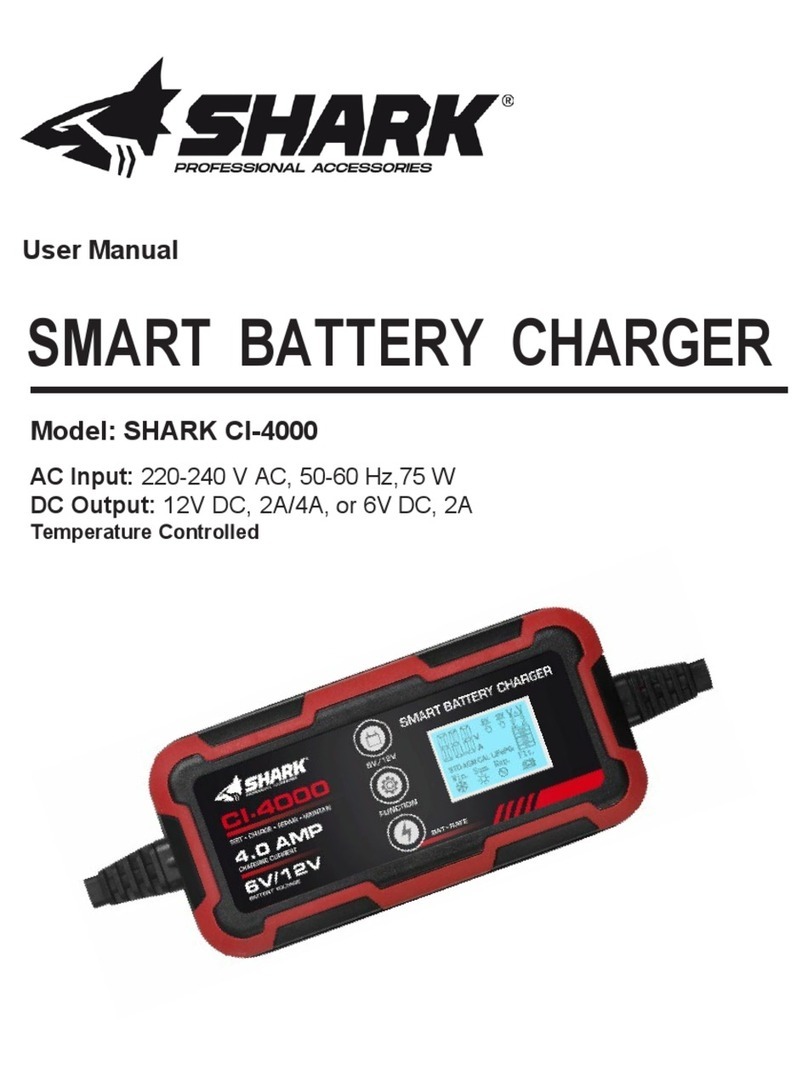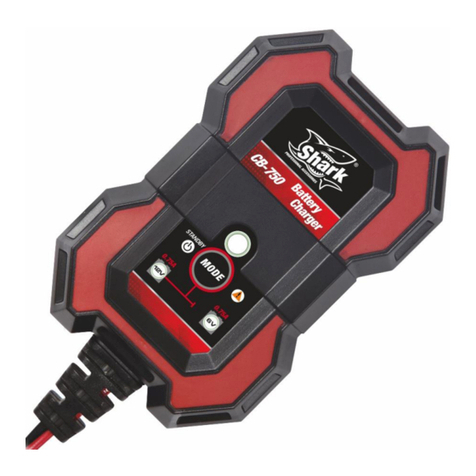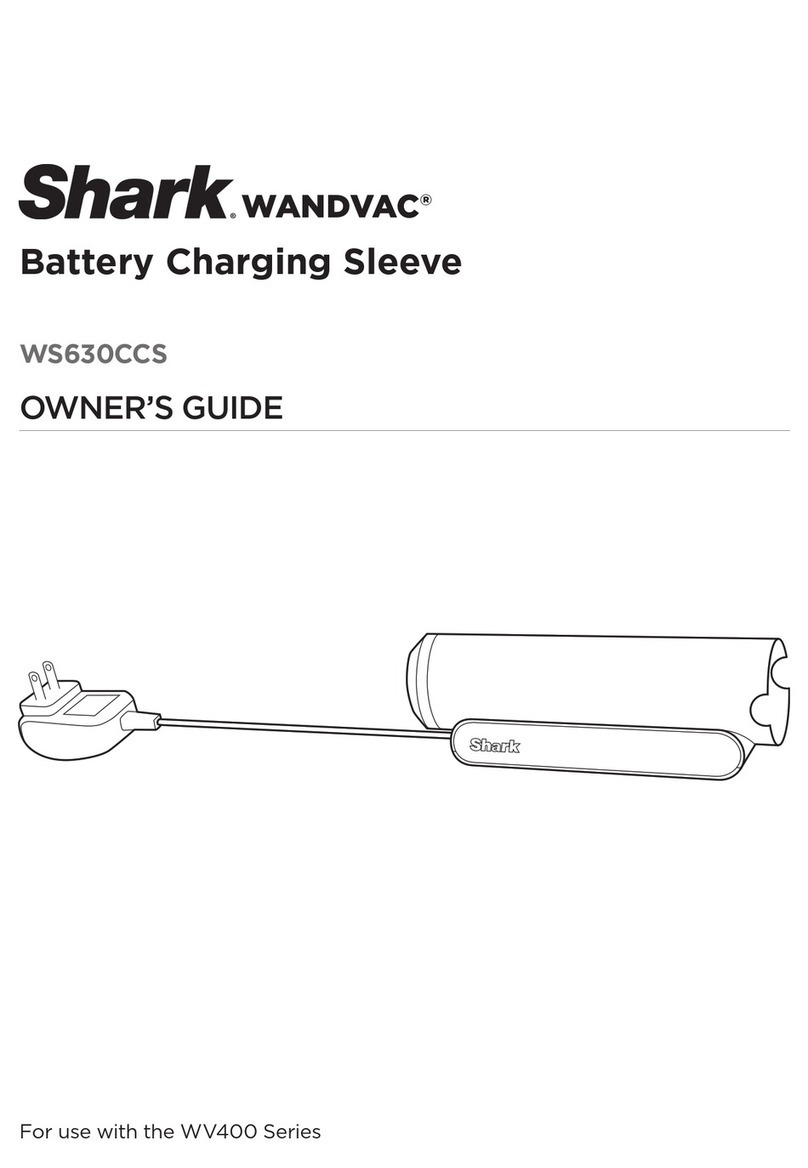Shark CN-4000 User manual

1
Shark Battery Charger
User Guide
Model: CB-750
AC Input: 220-240V AC, 50-60Hz, 0.25A
DC Output: 12V DC, 0.75A
6V DC, 0.75A
Please read and understand all important safety and operating instructions before using this
charger. In addition, please read and follow all battery and vehicle manufacturer’s instructions
and cautionary markings.

2
IMPORTANT SAFETY INSTRUCTIONS
SAFETY PRECAUTIONS FOR WORKING IN THE VICINITY OF A BATTERY
1)
Batteries generate explosive gases during normal operation. Use in well-ventilatedarea.
2)
Consider having someone close enough or within the range of your voice to come to your aid
when you work near a battery.
3)
Do NOT smoke, strike a match, or cause a spark in vicinity of battery or engine. Avoidexplosive
gas, flames and sparks.
4)
Remove all personal jewelry, such as rings, bracelets, necklaces, and watches while working
with a vehicle battery. These items may produce a short-circuit that could cause severe burns.
5)
Be extra cautious to reduce risk of dropping a metal tool onto the battery. It might spark or
short-circuit a battery or other electrical hardware which may cause an explosion or fire.
6)
Wear complete eye protection, hand and clothing protection. Avoid touching eyes while
working near a battery.
7)
Study all battery manufacturer’s specific precautions such as removing or not removing cell
caps while charging and recommended rates of charge.
8)
Clean battery terminals before connected with the charger. Be careful to keep corrosion from
coming in contact with eyes.
9)
When it is necessary to remove a battery from vehicle to charge, always remove grounded
terminal from battery first. Make sure all accessories in the vehicle are off in order to prevent an
arc.
10)
It is NOT intended to supply power to an extra-low-voltage electrical system or to charge
dry-cell batteries. Charging dry-cell batteries may burst and cause injury to persons and
property.
11)
NEVER charge a frozen, damaged, leaking or non-rechargeable battery.
12)
If battery electrolyte contacts skin or clothing, wash immediately with soap and water. If
electrolyte enters eye, immediately flood eye with running clean cold water for at least 15
minutes and get medical attention immediately.
SAFETY PRECAUTIONS FOR USING THE CHARGER
1)
Do NOT place the charger in the engine compartment or near moving parts or near the
battery; place as far away from them as DC cable permits. NEVER place a charger directly above
a battery being charged; gases or fluids from battery will corrode and damage charger.
2)
Do NOT cover the charger while charging.

3
3)
Do NOT expose to rain or wet conditions.
4)
Connect and disconnect DC output only after setting AC cord from electricoutlet.
5)
Use of an attachment not recommended or sold by the manufacturer may result in a risk of
fire, electric shock or injury to persons.
6)
Do not overcharge batteries by selecting the wrong charge mode.
7)
To reduce the risk of damage to electric plug and cord, pull by the plug rather than the cord
when disconnecting charger.
8)
To reduce risk of electric shock, unplug charger from outlet before attempting any
maintenance or cleaning.
9)
Operate with caution if the charger has received direct hit of force or been dropped. Have it
checked and repaired if damaged.
10)
Any repair must be carried out by the manufacturer or an authorized repair agent in order
to avoid danger.
ABOUT SHARK CB-750
1)
The CB-750 is perfect for keeping all of your 12V and 6V lead-acid batteries in top condition,
including WET (Flooded), GEL, MF (Maintenance-Free) and EFB (Enhanced Flooded Battery) .
2)
Built-in intelligent microprocessor makes charging and maintaining faster, easier and safer.
3)
This charger has safety features, including spark proof, protection for reverse polarity, short
circuit, overcurrent and overcharge.
4)
It has auto-memory, which returns to last selected mode when restarted.
5)
When Emerald Green LED is flashing, the charger is in bulk charge at a constant 1000mA
rated current output. When Emerald Green LED turns to solid, the battery is fully charged.
6)
Since this is a battery maintainer and you will keep it connected with vehicle battery for a
long time, do monitor monthly. Follow the battery manufacturer’s instructions for adding
distilled water if applicable.
7)
Following is the charger’s technical specification:
AC Input
220-240V AC, 50-60Hz, 0.25A
DC Output
12V DC, 0.75A;
6V DC, 0.75A
Start Voltage
> 1V
Housing Protection
IP60 - Protect from dust ingress

4
Battery Type
All Types of 6V and 12V Lead-acid
Batteries
Accessories Included
Clamp Connectors, Ring Connectors
Ambient Temperature
0℃~ +40℃
CONNECTING TO THE BATTERY
1)
Identify polarity of battery posts. The positive battery terminal is typically marked by these
letters or symbol (POS,P,+). The negative battery terminal is typically marked by these letters or
symbol (NEG,N,-).
2)
Do not make any connections to the carburetor, fuel lines, or thin metal parts.
3)
Identify if you have a negative or positive grounded vehicle. This can be done by identifying
which battery post (NEG or POS) is connected to the chassis.
4)
For a negative grounded vehicle (most common): connect the RED POSITIVE clamp / ring
connector first to the positive battery terminal, then connect the BLACK NEGATIV clamp / ring
connector to the negative battery terminal or vehicle chassis.
5)
For a positive grounded vehicle (very uncommon): connect the BLACK NEGATIV
clamp / ring connector first to the negative battery terminal, then connect the RED POSITIVE
clamp / ring connector to the positive battery terminal or vehicle chassis.
6)
When disconnecting, disconnect in the reverse sequence, removing the negative first (or
positive first for positive ground systems).
7)
Follow these steps when using 12V accessory plug (CB-750 does not have this accessory):
keep the vehicle hood open. Connect the end of the 12V accessory plug to the charger; insert
the 12V accessory plug into the vehicle’s 12V outlet. If the vehicle’s ignition key has to be on in
order for the 12V outlet to supply / receive power, turn the key, without starting the engine.
8)
A marine (boat) battery must be removed and charged on shore. To charge it on board
requires equipment specially designed for marine use.

5
CHARGING MODES
CB-750 has three modes: Standby,12V and 6V. Do not operate the charger until you confirm
the appropriate charge mode for your battery.
NOTICE: Make sure your battery to be charged / maintained is in good condition. The CB-750
cannot be used to recover severely discharged batteries or dead batteries.
How to deal with the batteries which are deeply discharged, but in good condition?
1.
Make sure the battery is in good condition (not dead) and was deeply discharged only. You
can use the battery analyzer to get the result if you have.
2.
Jumpstart your vehicle or use a battery charger with recovery function to activate the battery
until the battery voltage increases to normal condition. For 12V batteries, the normal voltage is
above 8 volt at least; for 6V batteries, the normal voltage is above 4 volt at least.
3.
Use the CB-750 Charger / Maintainer do the rest charging and maintaining work.
Mode
Explanation
Standby
Not charging or providing any power (Green LED)
12V
Charging and Maintaining 12V WET/GEL/MF/EFB
batteries (Blue LED)
6V
Charging and Maintaining 6V WET/GEL/MF/EFB
batteries (Green LED)
Other manuals for CN-4000
1
This manual suits for next models
1
Table of contents
Other Shark Batteries Charger manuals





















